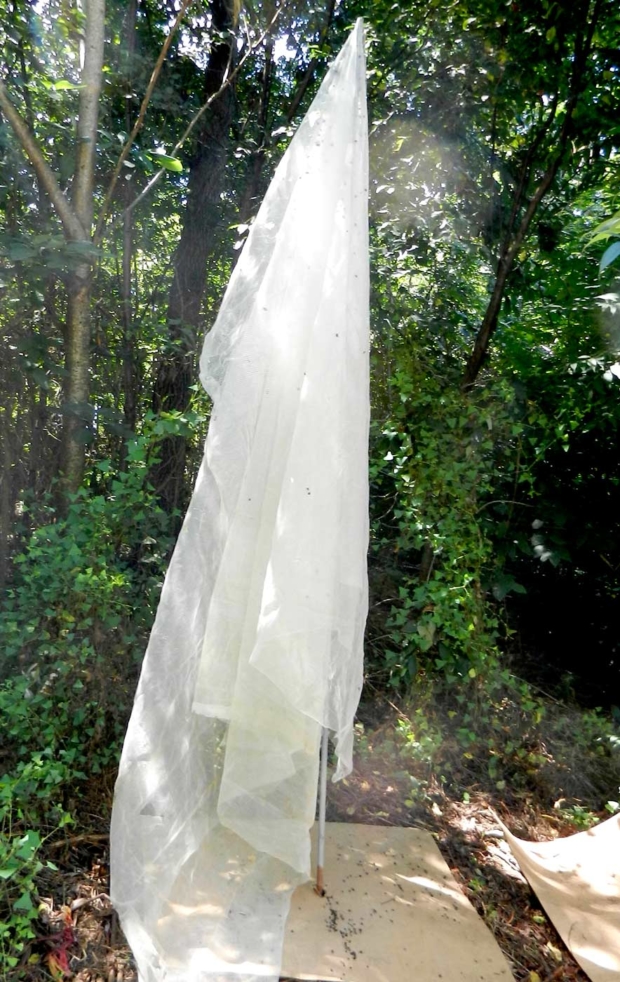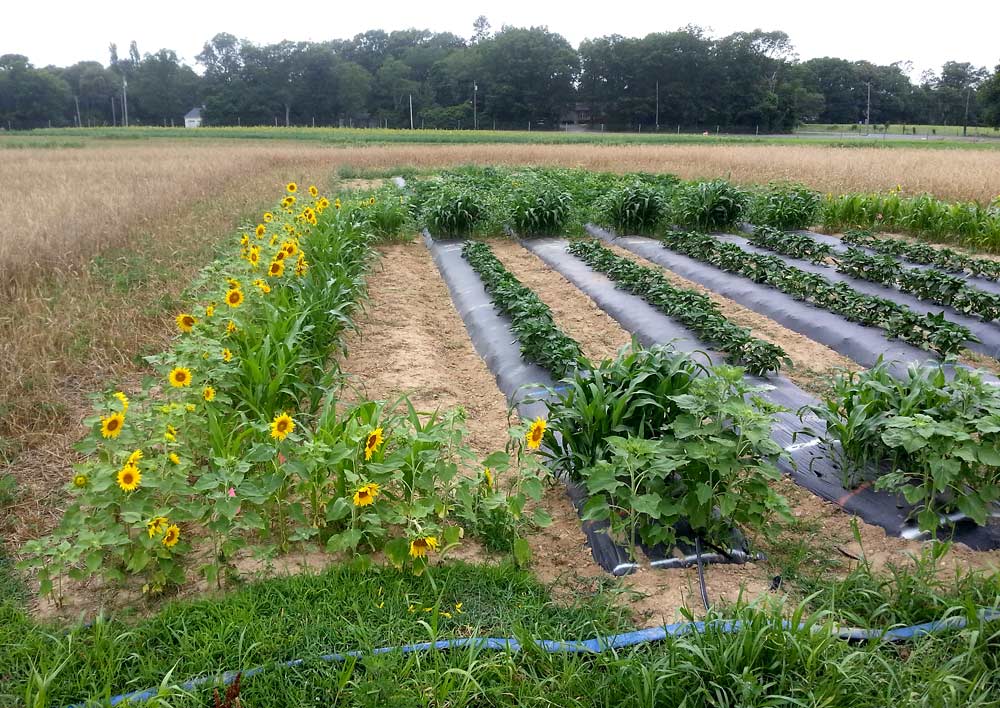
Tom Haas of Cherry Hill Orchards in Lancaster, Pennsylvania, had an idea in 2014: treat a piece of horticultural net with insecticide and aggregation pheromones for brown marmorated stink bugs; hang it in the orchard; and see what happened. His original treated net (shown here) evolved into a research project on such treated nets, which have come to be called “ghost traps” for their otherworldly appearance. (Photo by Greg Krawczyk)
Some apple orchards in Pennsylvania were surrounded by benevolent ghosts last year: a length of specially treated netting draped over a shepherd’s hook. Each successfully drew in and then killed hundreds of brown marmorated stink bugs.
The nets worked right through harvest time when brown marmorted stink bug (BMSB) numbers are at their highest, when growers have the fewest options available to combat them due to preharvest intervals that limit pesticide use, according to Greg Krawczyk, who presented results of the study at the December 2017 Great Lakes Fruit, Vegetable and Farm Market EXPO in Grand Rapids, Michigan.
Krawczyk is an extension tree fruit entomologist and research associate professor of entomology at Penn State University and its Fruit Research and Extension Center.
“On average, these treated nets that we are calling ‘ghost traps,’ killed more than 400 stink bugs per week. Those are huge numbers,” he said. “I’ve been studying brown marmorated stink bugs for the last eight years, and this is one of the most exciting things I’ve been working on.”
The idea for the nets arose in 2014, about four years after damaging levels of BMSB hit Pennsylvania orchards.
A local grower had taken a piece of horticultural net and treated it with insecticide, baited the net with the aggregation pheromone attractant for BMSB and then put it out in the orchard to see what would happen.
Krawczyk was intrigued, so he stepped in to help evaluate its effectiveness. “We started catching and killing a lot of stink bugs. They were attracted to the lure, coming into contact with the insecticide, and they were dying.”
Krawczyk spent the next two years experimenting with similarly treated nets, but couldn’t find one that would retain insecticide in the rainy East Coast weather until he came across a product made by Vestergaard Frandsen S.A. of Lausanne, Switzerland.
The company claimed that its nets could continue releasing insecticide for several years when used outdoors in Kenya, Africa. Krawczyk began working with additional researchers to test the nets’ performance in East Coast research orchards in 2016.
Encouraged by positive results from those initial tests, Krawczyk ran a replicated study in commercial orchards from July to October 2017. He baited the nets with aggregation pheromones, and draped them over 8-foot shepherd hooks so they were accessible to both flying adults and crawling nymphs. “Our thinking at this point was that the more stink bugs the net can intercept and kill, the less will be in the orchard,” he said.
It worked. While the average weekly kill per net was more than 400, in some weeks, that number was doubled.
Building on that success, he will be testing the nets this year to see whether they do indeed retain the insecticide for more than one season, and he will also be running experiments to learn the optimum spacing of the nets.
He notes that AgBio Inc. (www.agbio-inc.com) hopes to have the Vestergaard Frandsen nets registered as a monitoring tool by the U.S. Environmental Protection Agency in spring 2018 so it can begin selling them as such. “Combining nets with BMSB treatment threshold based on the presence of nymphs in monitoring traps should be especially useful for growers to reduce the numbers of insecticide applications targeting BMSB,” Krawczyk said.
In Pennsylvania, growers base insecticide treatments on the presence of nymphs. “We do that because adults can fly and come in from long distances, while nymphs cannot,” he said.
As a consequence, the discovery of nymphs means three things: Growers have a resident population of BMSB in the orchard; the nymphs will be there for at least the five to six weeks it takes them to become adults; and the bugs will be feeding and causing injuries during that time.

Greg Krawczyk
Overall, Krawczyk is not yet advising that every grower should immediately start hanging treated nets, but he says the nets show great promise. “We know we are killing huge numbers of stink bugs that are coming to these nets, and there is no contact in any way between those nets and any trees or fruit, so for certain situations and conditions, this might be an excellent option to monitor stink bugs and also maybe to provide relief from the stink bug pressure in the orchard, especially during harvest time.”
He also sees a potential for combining the ghost traps with a release of parasitoid samurai wasps, which prey on BMSB, to control the invasive stink bugs.
“On the East Coast, the samurai wasp has now been found in Maryland, Virginia, West Virginia, New Jersey, New York, and with a discovery by my graduate student Hillary Morin Peterson this past season, it has now also been found in Pennsylvania,” he said. “If we can work the ghost traps and the samurai wasps together, maybe sometime in the future we will have even more ways to monitor and control BMSB.”
Financial support for the ghost-trap project came from the State Horticultural Association of Pennsylvania Research Committee. Vestergaard Frandsen Company, AlphaScent Inc., Ag-Bio Inc., Sterling International Inc. and Trécé Inc. also provided support by way of donations and/or reduced prices of products used in the field trials. •

Rutgers University researcher Anne Nielsen’s group tests a combination sunflower-sorghum trap crop (sorghum not yet blooming) around the perimeter of a vegetable plot to learn whether the trap crop will reduce BMSB pressure in the vegetables. (Photo by Anne Nielsen)
Trap crops to control BMSB
Brown marmorated stink bugs are a particular problem for organic growers who don’t have access to the same insecticides that traditional growers use. One method under consideration is the use of trap crops to entice the invasive pests away from fruits. To test their effectiveness, researcher Anne Nielsen spent three years conducting field tests and presented the results at the December 2017 Great Lakes Fruit, Vegetable and Farm Market EXPO in Grand Rapids, Michigan. Nielsen is professor and extension specialist in fruit entomology at Rutgers University.
She oversaw small trap-crop trials on 11 organic farms and research farms in the Mid-Atlantic and the Southeast. Each site planted a sunflower/sorghum mix outside a plot of organic green peppers, which were chosen because they draw high pressure from BMSB.
Comparison between peppers grown with and without trap crops showed a reduction in minor injury in the trap-crop peppers, but no overall reduction in the total number of peppers that experienced at least some injury. “In other words, it just didn’t decrease the number of what we could consider culled fruits,” Nielsen explains.
“That doesn’t mean we’re abandoning trap crops altogether, because if managed properly, I think a trap crop system could control BMSB,” she said. Options she would like to see pursued include:
—Larger trap crops situated to intercept stink bugs moving into the peppers early in the season.
—Insecticides used once or twice per season in the trap crop to knock down BMSB.
—Incorporation of pheromones to increase the time that the stink bugs spend on the trap crop.
—Using trap crops to boost populations of samurai wasps, which would in turn reduce BMSB numbers.
“There’s a lot of potential with trap crops, because it’s a way to keep insecticides off of the crop itself, and that’s a benefit to growers whether they are organic or not,” she said.
Funding for this project was included as a small part of a $2.7 million grant from the USDA Organic Research and Extension Initiative program.
—by Leslie Mertz






I used some strips of batting (quilt type) to tie up plants. Didn’t work, but stink bugs or squash bugs laid eggs on it.